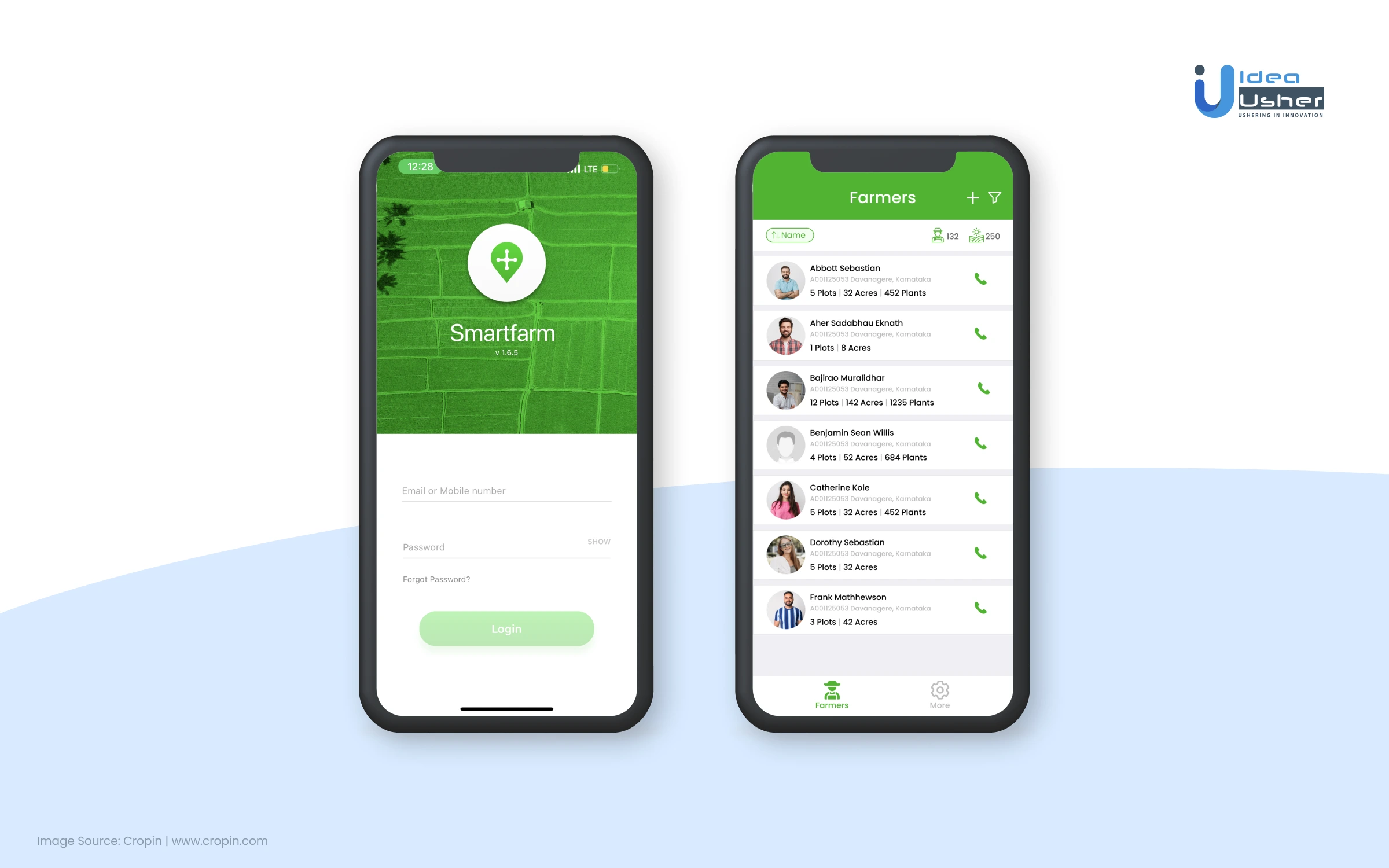Mobile apps have revolutionized the agriculture industry and have encouraged many in the agricultural business to know how mobile app can help their agriculture business.
At the start, it may be surprising to see the use of mobile apps in the agriculture industry, but it makes a lot of sense. Farmers can utilize modern technologies to amplify their business.
In the 21st century, there is an increase in the demand for agriculture app development. Many agro-business owners are interested in knowing how to build a mobile app for the agriculture industry.
Farmers are now adopting new and emerging technologies to amplify their business. Also, as per the research conducted by zion, the global smart agriculture market will grow from $5 billion in 2017 to over $15 billion in 2025.
This trend highlights the importance of mobile technology in the agriculture industry and the need for farmers to adopt innovative solutions to stay ahead of the competition.
Market overview of the smart agriculture industry
The following market stats indicate why it is an excellent opportunity to invest in the agriculture industry with app development:
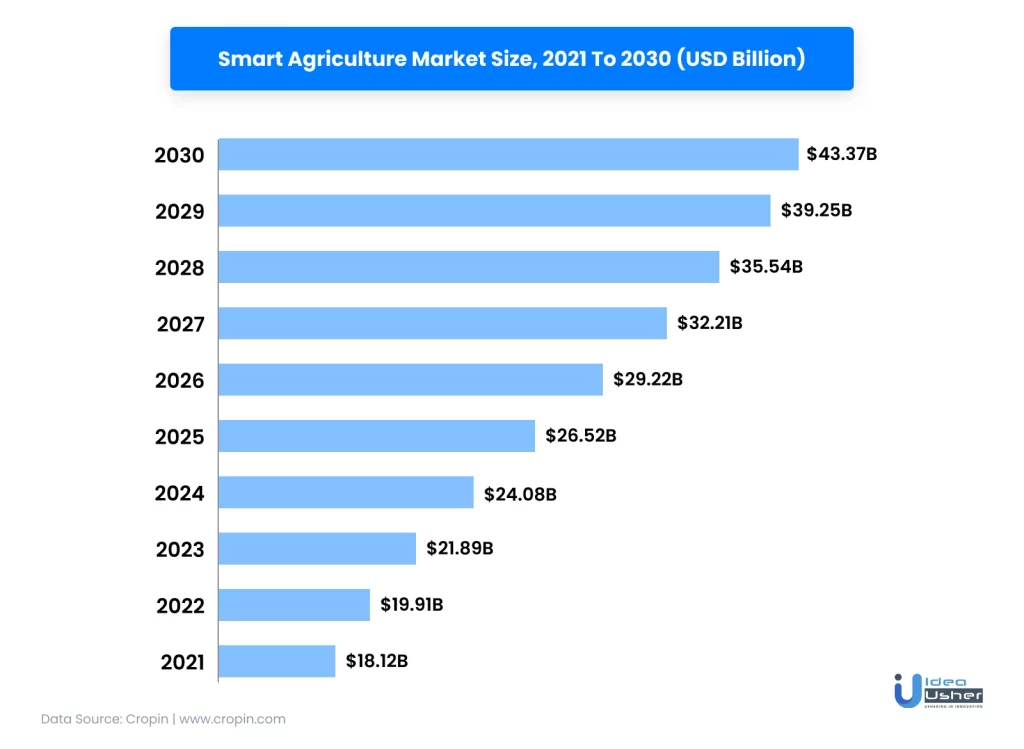
- As per the report of Grandviewresearch.com, the global market size of the smart agriculture industry was valued at $14.44 billion in 2021 and can grow at a CAGR of 10.8% from 2022 to 2030.
- The internet of things (IoT) in the agriculture market was valued at $12.5 billion in 2021 and is expected to reach $ 28.56 billion by 2030 at a CAGR of 9.62% from 2022 to 2030.
- The global drone market will cross $1.75 billion by 2030
- The smart sensor system segment will hit $2.85 billion by 2030
How agriculture benefits from the mobile app?
Mobile agriculture apps can tackle multiple problems. Check how mobile apps can benefit the agriculture industry:
| App benefits | For the agriculture industry | For farmers |
| Access to information | Market information Climate information | Better prices |
| Access to finance | Insurance Banking Credit | Better risk and disaster management |
| Control over the farm | Farming information | Real-time updates about their farmland |
| Enhanced distribution network | Direct link between farmers, buyers, and suppliers | Higher production prices through effective distribution |
1. Access to information
Mobile apps can provide vast information to farmers. The information may include weather forecasts and new data regarding farming activities such as cultivation, planting in harvesting.
Moreover, agriculture apps can also help guide and train a new workforce, allowing farmers to implement new methods for their crops.
2. Access to finance
Farmers can access various financial services with mobile apps, including payments, loans, general banking services, etc. Moreover, farmers can also select insurance plans through mobile applications.
Mobile apps can help farmers to simplify their payment process regarding purchasing items for their farming or receiving payments from their customers.
3. Easy access to input markets
Mobile app that helps farmers to get easier access to the input market. The input market includes all the necessary products the farmer needs to operate his farm effectively such as.
- Seeds
- Fertilizers
- Pesticides
- Irrigation system
4. Control over the farm
With a mobile app, farmers can create all new marketplaces where they will have the power to control and compare various products that they are offering to their customers.
5. Enhanced distribution network
Agriculture app development allows farmers to promote their products. Mobile apps play a crucial role in helping farmers to provide price information, marketplace formation, and the link between supply chains.
Check the required features to create an app for the farming industry.
Types of farming apps
Technology has revolutionized the agricultural industry by providing farmers with a wide range of innovative tools to improve their productivity and efficiency. The development of farming apps has played a crucial role in this transformation. These apps can assist farmers in all aspects of their business, from seed selection to market analysis, by providing real-time data and analytics.
1. GPS Tracking Apps
GPS tracking apps are used by farmers to track the location of farm equipment and vehicles. These apps use GPS technology to provide real-time information on the location and movement of tractors, combines, and other equipment, allowing farmers to optimize their operations and reduce downtime. Some popular GPS tracking apps for farmers include Fleetmatics, Trimble Ag Software, and FieldView.
2. Weather Forecast App
Weather plays a critical role in agriculture production, and weather forecast apps can help farmers plan their planting, irrigation, and harvesting schedules. These apps use real-time weather data and forecasts to provide farmers with information on temperature, rainfall, humidity, and wind speed. Some popular weather forecast apps for farmers include The Weather Channel, Weather Underground, and AccuWeather.
3. Mapping
Mapping apps for farming use satellite imagery and geographic information system (GIS) technology to create detailed maps of farm fields, including soil type, topography, and drainage patterns. These maps can help farmers plan their planting and irrigation strategies, optimize fertilizer and pesticide use, and identify areas of the field that may require additional attention.
4. Ranching App
Ranching apps are designed to help farmers manage their livestock, including tracking vaccinations, monitoring health, and managing breeding schedules. These apps can also provide real-time information on livestock prices, market trends, and weather conditions. Some popular ranching apps for farmers include CattleMax, Livestocked, and Ranch Manager.
5. Cattle Management App
Cattle management apps are specifically designed for farmers who raise cattle. These apps allow farmers to track the health and productivity of their herds, manage breeding schedules, and monitor feed and water consumption. Some popular cattle management apps for farmers include iLivestock, Herdwatch, and CowSense.
6. Grain Elevator App
Grain elevator apps allow farmers to manage their grain inventory and track prices in real-time. These apps enable farmers to view current market prices, manage contracts, and track deliveries to grain elevators. Some popular grain elevator apps for farmers include AgriDigital, Bushel, and FarmLogs.
Top 9 must-have features in a agriculture app
Here is the list of essential features you can add to your app.
1. Weather forecasting
Weather forecasting is a crucial aspect of mobile applications, particularly agricultural ones. By utilizing this feature, farmers can identify the weather conditions and determine the suitability of various crops.
This information can then be utilized to make informed decisions regarding planting and harvesting, ultimately leading to increased productivity and profitability.
Accessing accurate and timely weather forecasts can help farmers optimize crop yields and reduce the risk of crop failure.
2. Crop disease treatment
Mobile applications have the ability to connect farmers with global specialists who can provide expert advice on crop disease treatment. This feature allows farmers to consult with specialists remotely through video conferencing, eliminating the need for physical travel. This can be especially beneficial for farmers in remote or rural areas who may not have easy access to specialists in their local area.
The ability to consult with specialists remotely can help farmers quickly and effectively address crop disease issues, minimizing the impact on yields and profitability.
This feature also allows farmers to receive real-time, expert advice, which can be critical in preventing the spread of disease.
Additionally, consulting specialists from different regions can provide farmers with diverse advice and treatment options, increasing the chances of successfully treating crop diseases.
3. GPS tracking
Adding a GPS tracking feature to mobile agriculture apps can help farmers view their farmland and monitor their crops in real-time. With this feature, farmers can identify their crop’s location, growth status, and any issues that may arrive.
Moreover, this feature can enable farmers to track the location of farm equipment and vehicles, allowing farmers to manage their resources more effectively.
4. Goods listing
An e-commerce feature within an agricultural mobile application can provide farmers with a convenient and efficient way to purchase essential items such as pesticides, seeds, and other agricultural equipment.
By partnering with multiple vendors, the app can offer a wide range of products, providing farmers with more options and competitive prices.
Additionally, the e-commerce feature can also provide an additional revenue stream for the app, generating profits through commissions on purchases.
5. Agriculture schedule
An agricultural mobile application can include a crop timetable feature that allows farmers to schedule and manage their crop cultivation, planting, and harvesting activities. This feature can provide farmers with a comprehensive overview of their crop cycle, including dates for planting, fertilizing, and harvesting, as well as any other important tasks related to crop management.
Additionally, the feature can also provide farmers with alerts and reminders for tasks, such as applying pesticides or fertilizers, to help ensure that these activities are completed on time.
The crop timetable feature can also provide farmers with the ability to track their crop growth and yields over time, allowing them to make informed decisions about crop management and optimize yields
6. Calendar
A calendar feature is a vital component of an agricultural mobile application. This feature enables farmers to schedule and manage various cultivation, planting, and harvesting activities. The calendar can provide an overview of upcoming tasks, deadlines, and events, helping farmers to stay organized and on track.
Additionally, the calendar feature allows farmers to set reminders for important activities, such as fertilizing or applying pesticides, which can help ensure that these tasks are completed on time and in a timely manner.
The calendar feature can also be integrated with other features, such as weather forecasting, to provide farmers with a comprehensive view of their upcoming tasks and the best time to complete them based on the weather conditions.
Overall, the calendar feature plays an important role in streamlining farming operations and increasing productivity by helping farmers to schedule and manage their tasks effectively.
7. Payment gateway
A secure and reliable payment gateway is essential for any e-commerce-based mobile application, including agricultural mobile applications.
The payment gateway feature allows farmers to make transactions securely within the app to purchase essential items such as pesticides, seeds, and other agricultural equipment.
The payment gateway feature can be implemented by integrating with established payment processing providers, such as PayPal, Stripe, or Square. This integration can provide the app with various payment options, including credit/debit cards, online banking, and e-wallets.
To ensure the security of transactions, the payment gateway feature can use encryption and other security protocols to protect sensitive user data, such as credit card information. Additionally, the feature can provide farmers with purchase tracking and confirmation, as well as options for refunds and disputes.
8. Drone integration
Drone integration is one of the most important features of the mobile agriculture app. With drones, farmers can check the quality of their crops and make strategic decisions to improve their quality.
With drones, farmers can spread pesticides, collect soil samples, And can detect water leakage with the help of thermal cameras that attach to drones.
However, drones are subjected to some government restrictions, such as it is mandatory for drones to only fly during the day and should be visible to the operators all the time.
9. Video calls and broadcasting
Farmers can use this feature to connect with groups such as customers and business partners to strengthen their community.
Moreover, farmers can use video calls to join live video sessions regarding getting training from experts in the agriculture industry. The training will help farmers to implement new methods and improve crop quality.
To get the design and functionality ideas for your project, you can check the list of the best apps.
List of top 7 agricultural mobile apps
These are the following best apps for the agriculture industry.
1. FarmerLink
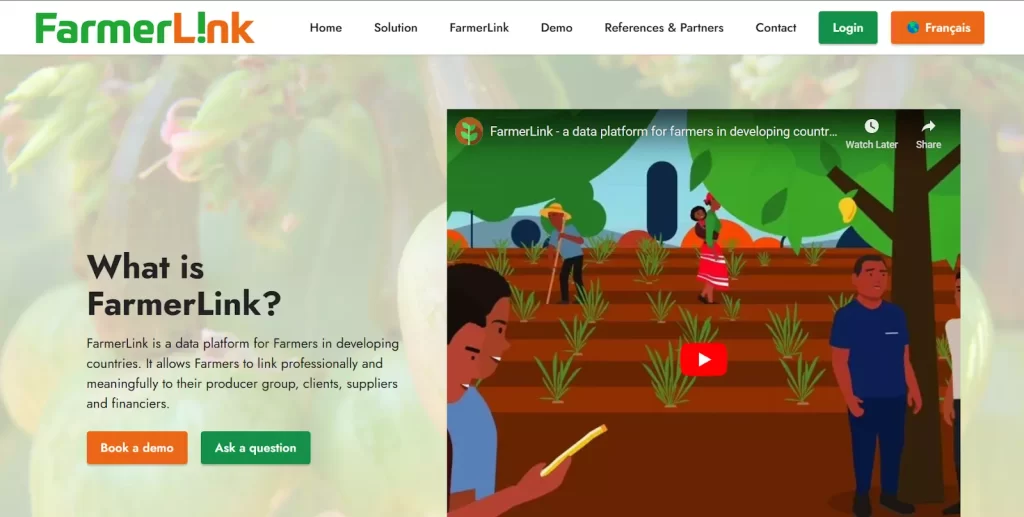
Farmer Link is a Philippines-based mobile app that offers satellite-based data to enable farmers to enhance their productivity. With FarmerLink, the farmers can connect with their producer groups, suppliers, clients, and financiers.
| Founded in | 2014 |
| Headquarter | Philippines |
| Available on | Web, Android & iOS |
| Top features | Farmer’s connectivity, Farm data capture, Analytics |
2. Conservis
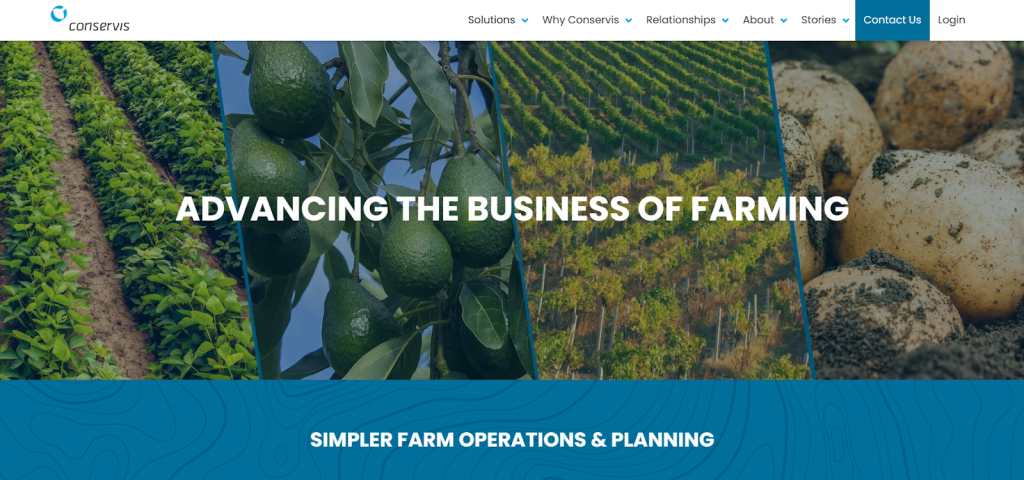
A farm management system that helps farmers to streamline their work process by enabling them to utilize the powerful analytical feature.
The platform allows farmers to store and analyze all their data in one place. Conservis offers its supply chain management where it showcased the whole workflow, and alerts farmers when there are any bottlenecks in it.
| Founded in | 2009 |
| Headquarter | USA |
| Avaialble on | Web, Android & iOS |
| Top features | Activity management, Accounting, Built-in accounting |
3. RML
The platform offers a subscription-based service that provides information to locals regarding commodity prices, weather, and crop cultivation. The app enables farmers to access real-time cost information for taking the right decisions.
| Founded in | 2007 |
| Headquarter | India |
| Available on | Web, Android & iOS |
| Top features | Educational agriculture content, Technology solutions, Farming methods |
4. SmartFarm
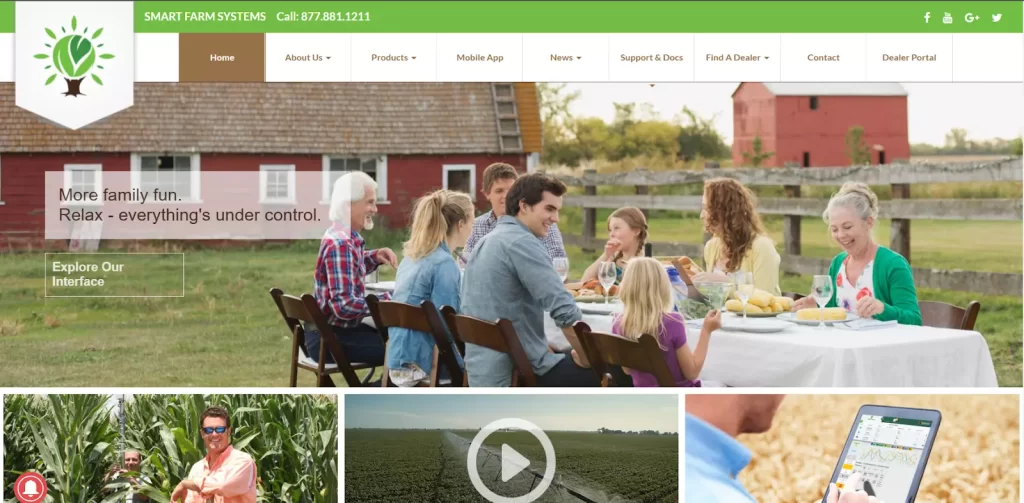
Smart Farm is a weather app that farmers can use for making better decisions to protect their crops. The app utilises modern technology such as machine learning, big data, and artificial intelligence to predict environmental changes.
| Founded in | 2013 |
| Headquarter | USA |
| Available on | Web, Android & iOS |
| Top features | Workflow automation, Built-in accounting, CRM |
5. Granular
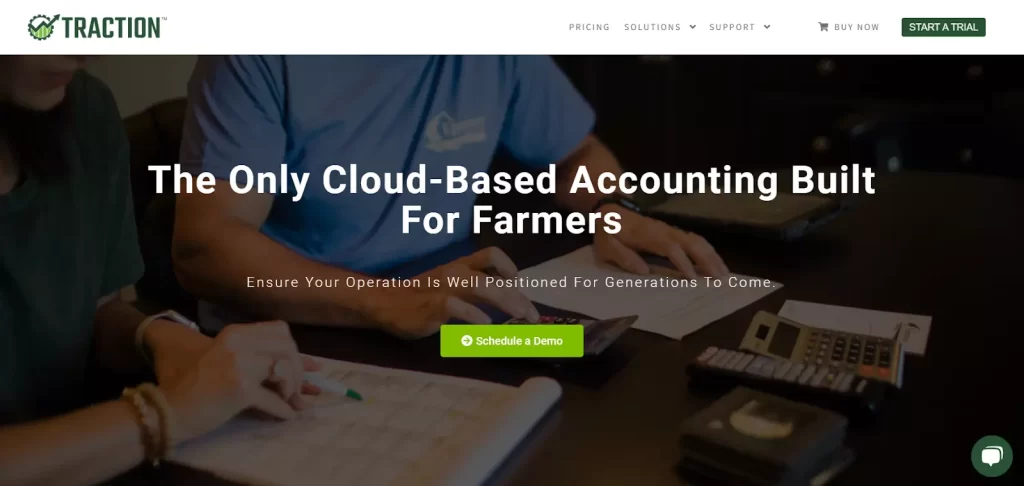
The platform built by Traction, offers financial insights based on data analysis. Granular allows farmers and advisors to unite and work together through better team management.
| Founded in | 2014 |
| Headquarter | USA |
| Available on | Web, Android & iOS |
| Top features | Inventory tracking & management, Field mapping & planning, Built-in accounting |
6. Agrivi
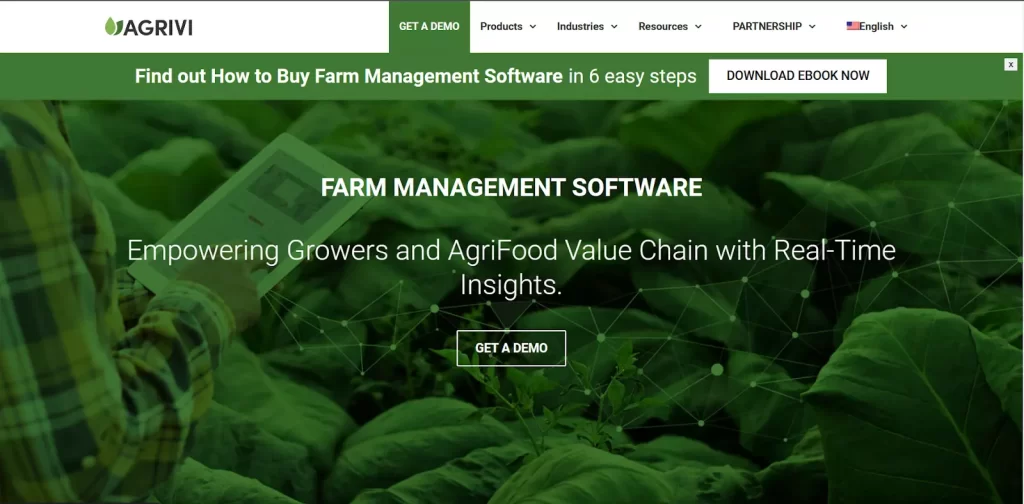
Agrivi provides effective staff resource management with a large database of different crops, pests, and diseases. Farmers can use this app to prevent their crops from pests and diseases by predicting the future harvest based on the app’s data.
| Founded in | 2013 |
| Headquarter | UK |
| Available on | Web, Android & iOS |
| Top features | Activity tracking & management, CRM, Built-in accounting, |
7. Agworld
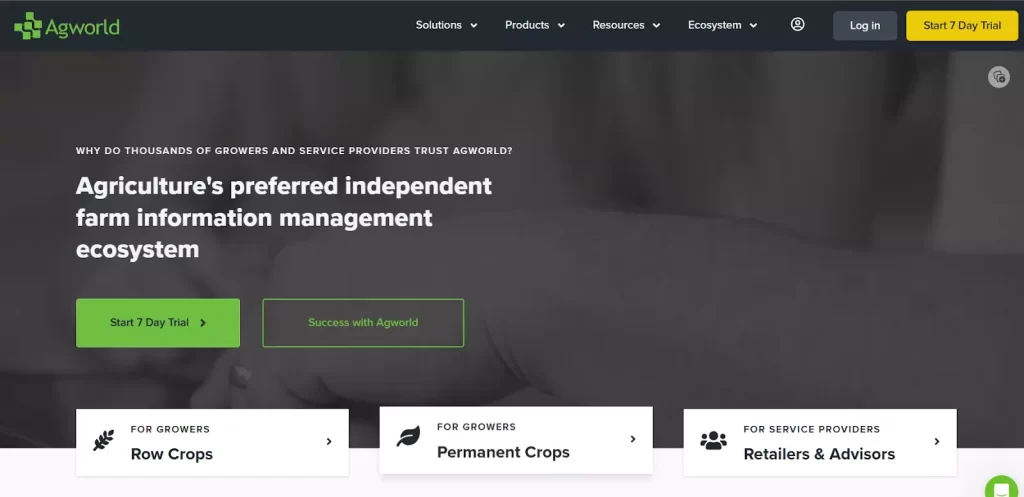
The app is famous for its farm manager app collaboration. Agworld allows quick scheduling and budgeting and offers a set of features that helps farmers to work in one team and get the best results.
| Founded in | 2009 |
| Headquarter | Australia |
| Available on | Web, Android & iOS |
| Top features | Crop livestock management, pricing management, Built-in accounting |
What is the development process for building an agriculture app? Let’s check.
How to build a farm app?
The following steps will help you to start app development for the agriculture industry
1. Project initiation
To initiate your project, you need a small team led by the project manager. The team should have a software architect and a few business analysts to create a well-documented project plan. Business analysts should gather and analyze the functional requirements that need to be offered by your app.
The team will also involve architects studying the industry benchmark for nonfunctional requirements like scalability, performance, maintainability, usability, security, etc. The project manager should implement reviews of requirements and technical solutions.
2. Review the best agriculture mobile apps
Many enterprises and start-ups offer the best agriculture applications. You can check the list of the best agriculture mobile apps and get to design and functionality ideas for your mobile app.
3. Create a list of required app features
Based on the desired functionalities of your agriculture app, you need to decide on the list of app features. The list of app features will depend on the goal of creating your app.
For example: offering an app for managing irrigation systems will have different features from an app that will be built for offering nutrient-related decision-making.
The features will also vary based on platforms, such as mobile apps that will offer features such as GPS tracking and field mapping. While for the web app, users might be able to set up details regarding farm management and agriculture production.
4. Plan the features for your project’s MVP
It’s our recommendation that you launch an MVP (minimum viable product) for your agriculture app. An MVP is a functional product with a few selected features.
MVP will help you to get market feedback from your potential customers, especially farmers who are going to use your app.
Moreover, you can enhance the quality of your app by choosing an Agile software development methodology.
5. Choose the technology stack
We recommend the following tech stack for your project:
| Front end development | JavaScript, HTML, CSS, Angular and React.js. |
| Back end development | Node.js |
| Android development | Java |
| iOS development | Swift |
| Artificial Intelligence & Machine learning | Python |
| IoT | Google cloud IoT, Microsoft Azure IoT Hub or Salesforce IoT |
| Database | SQL Database: MySQL NoSQL Database: MongoDB |
| API development | Postman |
6. Create a project plan
To ensure the success of your agriculture app, it is for you to create an effective project plan. When creating your project plan include MVP and its subsequent tasks, dependencies, schedule, and budget.
Moreover, also consider taking care of the following metrics such as quality standards, risk management, communication management, human resource management, stakeholder management, etc.
7. Hire developers for your project
It’s hard to create an agriculture app that competes with the best apps in the agriculture market. You need to hire a team of developers that offer required roles for your project such as:
- UI (user interface) designers;
- Web developers;
- Android developers;
- iOS developers;
- AI/ML developers;
- IoT developers;
- Testers;
- DevOps engineers.
But how do you hire the best developers? Should you hire developers from freelancing websites or app development companies?
Although multiple freelancing platforms exist where you can hire developers at low hourly rates, however, we would not suggest you hire developers from freelancing sites.
Executing your project with part-time freelancers involves many challenges, such as team management, communication, retaining them in the long term, etc.
We recommend you hire app developers from a trustworthy software development company. Such companies provide full-time developers under the same condition that you get when you hire developers from freelancing websites.
Developers from reputed software development companies have the skills, experience, and motivation to deliver complex projects for their clients and offer other required services such as project management, market research, project release, deployment, etc.
How can Idea Usher help ?
We offer you a proven solution to meet the specific needs of your business. Our team has experienced developers that will work on your project to offer you a digital platform to make revenue from farmers and customers in the agricultural industry.
We use the latest technology and best practices to ensure that your app is secure, scalable, and user-friendly. Our app development process includes a proven process from market research to deploying your app.
By leveraging our expertise in custom app development, a digital platform that improves productivity and efficiency in agriculture operations, which eventually helps you to generate more revenue from your customers.
Contact us today to learn more about how we can help you unlock the full potential of your agriculture app.
Contact Idea Usher
Work with Ex-MAANG developers to build next-gen apps schedule your consultation now
Email:
Phone:
FAQ
1. How do you develop agricultural apps?
You can follow the given steps to build an app for the agriculture industry:
- Create an app strategy
- Analyze market trends
- Design and build app features
- Perform beta testing
- Launch your app
2. What are the technologies used in smart agriculture?
Smart agriculture uses the following technologies:
- IoT in Agriculture
- Semi-automatic robots
- Smart Greenhouses
- Drones
- Smart remote sensing
- Computer imaging
